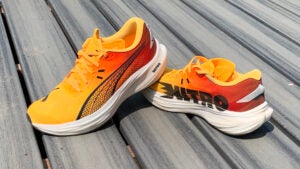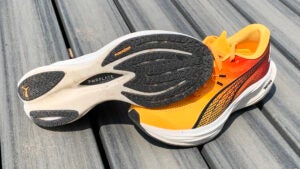New perk: Easily find new routes and hidden gems, upcoming running events, and more near you. Your weekly Local Running Newsletter has everything you need to lace up! Subscribe today.
When the first Puma Deviate Nitro came out in spring 2021, it was one of the first flexible-plated shoes in this new world of super shoes, and quickly impressed with its smooth cushioning and lively-but-accommodating roll and toe-off. Not knowing how to classify it, we called it a “semi-super shoe” to distinguish it from powerful-but-prescriptive, rigid-carbon-plated super shoes like its accompanying racing model, the Deviate Nitro Elite.
Three years later, the class of shoes the Deviate Nitro fits into has become known as “super trainers” and is burgeoning with new models. This third version of Puma’s super trainer holds its own in the lead pack of this class and, while still paired with its flashier super shoe sibling, can stand on its own as a versatile trainer/racer for a wide range of runners.

Puma Deviate Nitro 3
Weight: 7.7 oz (women’s 7), 9.3 oz (men’s 9)
Stack Heights: 39mm (heel), 29mm (forefoot)
Heel-to-toe Drop: 10mm
When you buy through our links, we may earn an affiliate commission. This supports our mission to get more people active and outside. Learn more.
$160 at Running Warehouse—Men’s
$160 at Running Warehouse—Women’s
At a Glance
Pros:
+ Comfortable, stable landing, smooth roll and energetic push-off
+ Complements stride at a wide range of paces, from easy recovery to threshold
+ Plush, stretchy upper coddles even weird feet while staying secure
Cons:
– Slightly heavier than some competitors
– Heel lift a bit high for some runners and paces
What’s New:
- Stack height increased by 3mm in the heel, 1mm in the forefoot
- Plate reshaped to encourage roll off big toe
- Forefoot sole rubber reduced slightly, improving flexibility
- Midfoot shaved narrower for sleeker ride
Puma made only minor changes to the Deviate Nitro 3, keeping the key elements that have made it a favorite super trainer while improving its prowess at everyday training paces. Retained is the two-layer midsole with a firmer, smooth-rolling nitrogen-infused TPEE foam on bottom—thicker in the heel below the curved plate—and a softer, more explosive nitrogen-infused PEBA foam on top—predominantly in the forefoot where the plate curves away from the foot.
The two foams are the same as in the Deviate Nitro 2, but the PEBA foam lost its “Elite” name because that now refers to the brand’s highest-responding, Aliphatic TPU foam found in the Deviate Elite 3 and Fast-R Nitro Elite 2. The PEBA foam was retained in the Deviate Nitro 3 to provide a different ride, more suited to a training shoe. Conor Cashin, a senior product line manager at Puma running, says, “In the PEBA-based foams, the runner will experience a softer underfoot ride. The Aliphatic TPU provides more rebound with a higher responsive ride. Overall, you get a more energetic and ‘faster’ feeling in the Aliphatic TPU.”
The plate on the Deviate Nitro 3, Cashin explains, is made using carbon fibers, but is a composite material, woven to flex just enough to accommodate different paces and strides more effectively than the rigid, thermal-formed plate on the Deviate Nitro Elite. The foreward half of the plate is also forked to allow more independent movement as you roll off the toe. Version 2’s plate was also forked, but its lateral segment was shorter; both are the same length on the new version. Cashin says they found that “runners were taking the path of least resistance and rolling outward. We wanted runners rolling off the big toe.” The change, Cashin says, gives the foot a better movement pattern and more power.
One to three millimeters of additional stack height—all added to the softer foam above the plate and a cushier sock liner—echos an increase in the Deviate Elite’s height. “They’re married: Deviate is the training partner to Deviate Elite,” Cashin says. “We wanted to make sure that the stack height was close so that the familiarity underfoot from training day to race day was there.” As for the two-millimeter increase in drop, giving it a steeper ramp angle, the goal, Cashin says, was to “make it more of an everyday shoe, more forgiving.”

Puma Deviate Nitro 3: First Impressions
I’ve worn the Deviate Nitro 3 nearly every day for two weeks, with runs that included easy daily jogs, an hour-long steady run, a tempo run, some 800-meter fartlek pick-ups, and a session of short sprints.
The shoe balances comfort, support, and liveliness as well as any super trainer I’ve tested. The near-max height midsole manages to be comfortably cushioned without giving up all ground feel. Touchdowns are greeted by the superball-like, controlled cushioning of the lower, firmer, TPEE foam, which speeds my stride smoothly through to the softer, PEBA foam that makes up most of the midsole under the ball. The early rocker lets my forefoot sink into that soft, responsive upper layer, but not too far before it is gently caught and channeled forward by the long curve of the flexible plate and the firmer foam below it.
The plate is flexible enough and embedded deep enough in the thicker top layer that I never really felt it except for the gentle guiding of the foams’ compression and rebound. Unlike the rigid plate in the Deviate Elite 3—and most super shoes—I never felt it directing my foot roll or fighting my preferred movement pattern. This adaptability also reduces its effect somewhat—the ride feels efficient and leg-saving, but not explosively speedy.
The firmer base foam, combined with the plate and the wide, flared forefoot, deliver excellent stability. I enjoyed this most on recovery days when my legs were tired and my stride floppier, but also appreciated the supportive platform underneath the squish and bounce when pushing off at faster paces.
The engineered mesh upper with strategic “tape” overlays and moderate padding was always comfortable, combining a light stretch and large-hole breathability with enough support to keep my foot secure. It accommodated without difficulty my foot that has a small bunion and the extra width from wearing Correct Toes to keep my big toe aligned and engaged. My only complaint was that the flat laces stretched a bit too much, making me have to tie them tighter than I wanted so they’d feel right once they stretched to length and started securing. This improved over the test period as the laces broke in more.
While Puma slightly reduced the amount of rubber on the sole to lower the weight and increase flexibility, it wasn’t missed. There is still plenty of Puma’s sticky PUMAGRIP to provide excellent traction on dry and wet roads, and the exposed TPEE midsole showed no signs of wear yet.
What impressed me most was the Deviate Nitro 3’s versatility. I had run in the Deviate Nitro Elite 3 first, and its hyper-bouncy, forward-balanced ride synced with my stride only when I was pushing 10K pace or faster. In contrast, the Deviate Nitro, was not only much more stable but also rolled smoothly, heel to toe, even at my easy warm-up pace—around a 10-minute-mile these days. When I picked up the pace, the shoe kept up, matching my turn-over and push-off with a springy response, hitting its sweet spot at marathon pace down to a cruising threshold pace. The shoe worked exceptionally well for Fartlek workouts, where it cruised through every pace change without missing a beat.
Only when I exceeded 5K race pace—especially when I tried to sprint—did the shoe get a bit awkward, with the forefoot wanting to roll with long strides rather than pop quickly off the toe and the 10mm heel lift getting in the way.
Despite its everyday versatility, Puma’s main focus for the shoe, Cashin says, is as an uptempo trainer that prepares you for running in one of their race-tuned super shoes. “It’s more about how to elevate your training to get ready for race day,” he says. “You can do long runs in it and get carbon experience but not have to wear your race day shoe, so when you go into your race day shoe you have the plate and it’s not so unfamiliar to your legs.”
Surprisingly, after wearing them exclusively for a week, I didn’t feel like I needed a break from the Deviate Nitro 3. I could easily see using them for every workout except when doing short fast speedwork and on days when I wear a more minimal, flexible shoe for foot strengthening.

Puma Deviate Nitro 3: Who Is It For?
The Deviate Nitro 3 is a great choice for any runner who wants the soft underfoot feel and lively ride of a super shoe without giving up stability or flexibility. It will be most appreciated by runners who like a firmer base and some ground feel under a soft touchdown, and those who find that rigid-plated super shoes try to alter their stride adversely.
Some runners might reserve it for up-tempo workouts and long runs as a companion to a rigid-plated super shoe, while others could comfortably wear it as an everyday trainer, as it rides smoothly even at slow paces.
Cashin also says—and I agree—“Deviate can also be a great marathon racer for someone who is running 8-, 9-, 10-minute pace. They can get some of the efficiency from the foam and the plate, yet they’re in something that’s more comfortable and more forgiving—and paying $100 less.”
Similar Shoes
Saucony Endorphin Speed 4 and Pro 4, Adidas Adizero Boston 12, Asics Gel Magic 3, On Cloudmonster Hyper, Hoka Mach X 2, Brooks Hyperion Max 2
